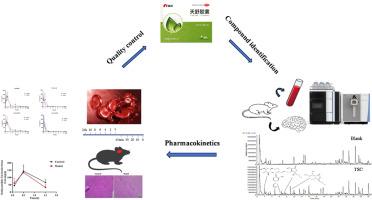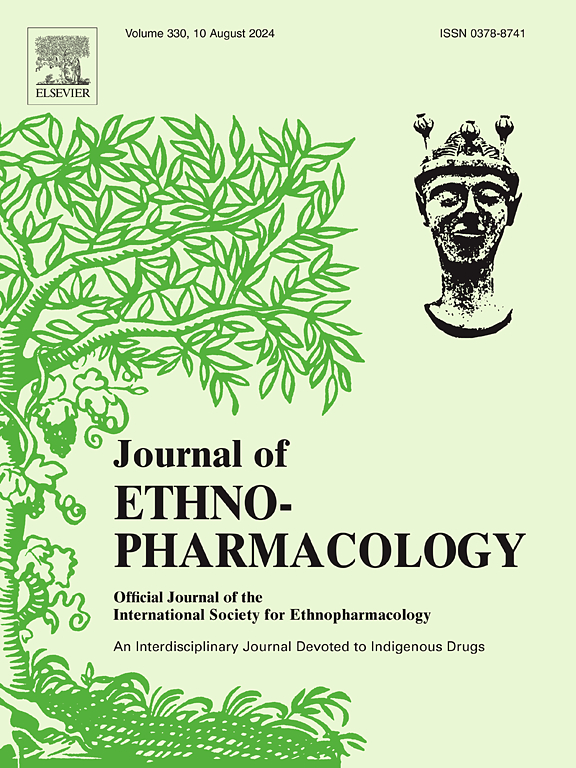Pharmacokinetics of the material basis compounds of Tianshu capsule in treating migraine
IF 4.8
2区 医学
Q1 CHEMISTRY, MEDICINAL
引用次数: 0
Abstract
Ethnopharmacological relevance
Tianshu capsule (TSC) is a traditional Chinese medicine (TCM) preparation and has significant clinical effect on migraine. The composition characteristics of TSC formula are worth exploring for the treatment of migraine.
Aim of the study
Identify the compounds in vivo after oral administration of TSC, Gastrodin (GAS), ferulic acid, senkyunolide G and senkyunolide I in the blood of healthy and migraine rats were used as representative compounds for time-dependent processes investigation. And we focus on explaining the characteristics of TSC treatment on migraine from a pharmacokinetic perspective.
Materials and methods
In this study, Ultra-high performance liquid chromatography with Orbitrap tandem mass spectrometry (UPLC-Orbitrap-MS/MS) system were used to detect the compounds in rat plasma and brain after oral administration of TSC. A sensitive, selective and reliable ultra-performance liquid chromatography coupled with triple quadrupole mass spectrometry (UPLC-TQ-MS/MS) system method was established for the simultaneous quantitative analysis of multi-components and evaluate the pharmacokinetic behavior of four main compounds.
Results
A total of 46 compounds were significantly identified in vivo of rat, including 35 compounds in plasma, 7 compounds only in brain and 4 compounds both in plasma and brain. The quantitative method has been confirmed to be feasible for multi-components content determination, pharmacokinetic parameters indicated that the four compounds absorbed into blood rapidly, and senkyunolide I also cross the blood-brain barrier (BBB) quickly into brain. GAS has relatively high concentrations in plasma, and the parameters AUC0-t, CLz/F displayed significant differences between the normal and migraine rats. And the AUC0-t and Cmax of GAS and ferulic acid exhibited dose-dependent way.
Conclusions
we added compounds for the pharmacokinetic study of TSC, providing powerful help for clinical medication in the treatment of migraine.

治疗偏头痛的天舒胶囊物质基础化合物的药代动力学。
民族药理学意义:天舒胶囊(TSC)是一种传统中药制剂,对偏头痛有显著的临床疗效。天舒胶囊配方的成分特点在治疗偏头痛方面值得探讨:研究目的:以健康大鼠和偏头痛大鼠血液中的天麻素(GAS)、阿魏酸、川芎内酯 G 和川芎内酯 I 为代表化合物,对口服天麻素后的体内化合物进行时间依赖性过程研究。材料和方法:本研究采用超高效液相色谱-Orbitrap串联质谱(UPLC-Orbitrap-MS/MS)系统检测大鼠口服TSC后血浆和大脑中的化合物。建立了一种灵敏、选择性好、可靠的超高效液相色谱-三重四极杆质谱(UPLC-TQ-MS/MS)系统方法,用于同时定量分析四种主要化合物的多种成分并评估其药代动力学行为:结果:在大鼠体内共鉴定出46种化合物,其中35种在血浆中,7种仅在脑中,4种同时在血浆和脑中。药代动力学参数表明,四种化合物在血液中吸收迅速,森久内酯Ⅰ也能迅速通过血脑屏障(BBB)进入大脑。GAS 在血浆中的浓度相对较高,其 AUC0-t、CLz/F 等参数在正常大鼠和偏头痛大鼠之间存在显著差异。结论:我们为TSC的药代动力学研究添加了化合物,为偏头痛的临床药物治疗提供了有力的帮助。
本文章由计算机程序翻译,如有差异,请以英文原文为准。
求助全文
约1分钟内获得全文
求助全文
来源期刊

Journal of ethnopharmacology
医学-全科医学与补充医学
CiteScore
10.30
自引率
5.60%
发文量
967
审稿时长
77 days
期刊介绍:
The Journal of Ethnopharmacology is dedicated to the exchange of information and understandings about people''s use of plants, fungi, animals, microorganisms and minerals and their biological and pharmacological effects based on the principles established through international conventions. Early people confronted with illness and disease, discovered a wealth of useful therapeutic agents in the plant and animal kingdoms. The empirical knowledge of these medicinal substances and their toxic potential was passed on by oral tradition and sometimes recorded in herbals and other texts on materia medica. Many valuable drugs of today (e.g., atropine, ephedrine, tubocurarine, digoxin, reserpine) came into use through the study of indigenous remedies. Chemists continue to use plant-derived drugs (e.g., morphine, taxol, physostigmine, quinidine, emetine) as prototypes in their attempts to develop more effective and less toxic medicinals.
 求助内容:
求助内容: 应助结果提醒方式:
应助结果提醒方式:


